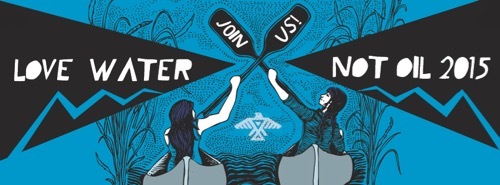The summer of 2015 finds Native communities in Minnesota and the Dakotas fighting a multi-front war to protect precious water resources from big oil and uranium mining. There is a compelling Sioux spiritual belief that says tribes have a duty to protect "Unci Maka" for seven generations. "Unci Maka" is Lakota for "Grandmother Earth." The Fort Laramie Treaty of 1868 provides the legal argument that tribes have jurisdiction over all water, both above ground and in aquifers on treaty lands. The agreement marked the end of Oglala Sioux Chief Red Cloud's war against the United States.
But the spiritual and legal battles over stewardship continue to this day. While the spiritual argument for protecting Earth's resources is a necessary moral imperative, Native Americans find themselves immersed in judicial technicalities that ignore tradition and the sacred duties given to them by their Creator. If a pipeline snakes around a reservation boundary, a boundary that does not include the larger 1868 perimeter, surface and groundwaters are still vulnerable to a spill. Also imperiled are drinking and irrigation waters that the people depend upon.
This week, the South Dakota Public Utilities Commission (PUC) began a hearing for TransCanada's recertification of the permit for the Keystone XL pipeline route across South Dakota. The five-year limit has passed since the initial 2010 certification, which included the caveat that construction would begin in four years. President Obama did not give his approval, so the process must begin again.
Even though the proposed pipeline will run through treaty lands, the PUC is denying input from native communities.
The PUC is insisting that it does not have the jurisdiction to rule on whether TransCanada is violating the 1868 treaty. The bottom line is that regulators won't allow testimony on tribal land stewardship during the pipeline hearings. Potential breaches in the pipeline could pollute the Ogallala Aquifer.
Dr. Sara Jumping Eagle wrote an impassioned op-ed at OEN, criticizing the PUC decision to deny input from the affected tribes.
"Will we wait another 50 years for medical societies to make policy statements defining the public health threats of oil and associated chemicals in our drinking water?" she asked.
The toxic mix that helps the tar sands dilbit flow through pipelines contains bitumen oil and diluents, benzene, toluene, and micro-polyaromatic hydrocarbons (PAHs). Once these PAHs are spilled, they turn into gasses in the surrounding area, causing symptoms such as nausea, dizziness, headaches, coughing, and fatigue in people and wildlife. PAHs are health hazards and cause respiratory issues such as asthma; they also cause cancer, and hormone and reproductive problems by disrupting neuroendocrine transmitters and interfering with DNA functions.
Jumping Eagle is a pediatrician and originally from the Pine Ridge Reservation. She lives and works in Fort Yates, North Dakota on the Standing Rock Sioux Reservation. Standing Rock extends into South Dakota.
In Minnesota Honor the Earth is fighting the Canadian corporation Enbridge's attempts to extend its pipelines from Canada and create a new pipeline, the Sandpiper, which will bring oil from the Bakken fields to refineries on Lake Superior.
The third annual "Love Water Not Oil Tour" is a spiritual battle against the proposed Enbridge pipelines. Organizers and supporters will ride horses and paddle canoes in a symbolic ride upstream against a current of oil that hopefully, "will never come," say organizers. Wild rice, the physical and spiritual embodiment of nourishment for the Anishinaabe, grows in the pristine lakes that are vulnerable to pipeline spills.
The Enbridge Sandpiper line is poised to carry oil from the Bakken Oil Field across Minnesota's White Earth reservation. This highly volatile cargo has incinerated a town in Canada and caused several evacuations of small towns on the Great Plains. The Three Affiliated Tribes are located in the epicenter of the Bakken in North Dakota on the Fort Berthold reservation. Proponents say pipelines are safer that rail, but pipelines leak.
Consider the tar sands dilbit spill last week in Alberta of 1.3 million gallons. This was a new pipeline with the latest monitoring technology.
The Enbridge Alberta Clipper pipeline, which already crosses the Minnesota Red Lake Reservation, is going through an approval process to double its capacity to carry tar sands oil. This pipeline has leaked on numerous occasions, threatening the waterways and wild rice beds of northern Minnesota. The proposed line would be bigger than the Keystone XL.
Enbridge is looking at a $40 million penalty for spilling 1 million gallons of tar sands oil into Michigan's Kalamazoo River five years ago. Is this simply the cost of doing business?
Imagine the devastation to native communities if a spill of this magnitude happened in wild rice country.
Manoomini Giizis, the Dinner of the Wild Rice Moon, prepared by the Sioux Chef, is scheduled for August 27 in Nisswa, Minnesota. The complete list of Love Water, Not Oil events can be found here.
Oil is not the only concern in South Dakota. Native communities have been fighting uranium mining for thirty years. Cancer, liver disease, diabetes and other health problems have afflicted the Oglala Lakota people on the Pine Ridge Indian Reservation for decades.
"The Pine Ridge Reservation is rich in Lakota culture and history. What most people think of is that it is the land of Red Cloud, Crazy Horse, Black Elk. We are not dusty relics on a museum shelf though, we are living and breathing in todays world, and we need help to fund our case against Cameco, Inc. the worlds largest uranium miner," says Debra White Plume in a website statement.
Opponents of uranium mining won a reprieve in May of this year when the Nuclear Regulatory Commission's Atomic Safety and Licensing Board (ASLB) ruled that Nuclear Regulatory Commission staff had not consulted adequately with tribes to protect cultural sites. More importantly, the ASLB noted the "potential for water contamination from abandoned, preexisting bore holes."
The potential for devastating health consequences to Native populations from uranium mining hardly ever makes the news cycles. The film Crying Earth Rise Up is literally a cry for help for Mother Earth. Learn more about the production here.
In this summer of spiritual and legal efforts by Native communities to protect precious resources, it is good to know the high stakes in this dangerous game of profit vs. health.


